What is walk through metal detector?
A walk through metal detector, also called door frame metal detector and archway metal detector, is a security device used to detect metallic objects and contraband carried by individuals in areas such as airports, stadiums, and government buildings.
It is made of a rectangular frame with multiple panels that emit and detect electromagnetic fields. When a person walks through the metal detector, the electromagnetic fields are disturbed if they are carrying metallic items like keys, coins, or weapons. This disturbance triggers an alarm, informing security personnel of the presence of metal objects on the person. Walkthrough metal detectors can work with turnstile gates for higher security.

Types of walk through metal detectors
There are two main types of walkthrough metal detectors: single-zone and multi-zone. Single-zone detectors have one detection area and are commonly used in low-security environments. Multi-zone detectors have multiple detection zones, offering more precise localization of metal objects and are commonly used in high-security settings like airports.
1. Single-Zone Metal Detectors: These detectors have one detection zone and are suitable for basic metal detection needs. They can detect metal objects as people walk through the detector.
2. Multi-Zone Metal Detectors: Multi zone walk through metal detector has multiple detection zones, typically ranging from 6 to 33 zones. It provide more precise metal detection by indicating the location of the detected metal through different zones on the detector panels.
3. Hand-Held Metal Detectors: Hand-held metal detectors are portable devices used by security personnel to scan individuals manually. They are commonly used in conjunction with walk-through metal detectors for secondary screenings.
4. Portable Metal Detectors: These detectors are similar to walk-through metal detectors but are designed for temporary use or to be easily moved. They are often used in situations where permanent deployment is not required.
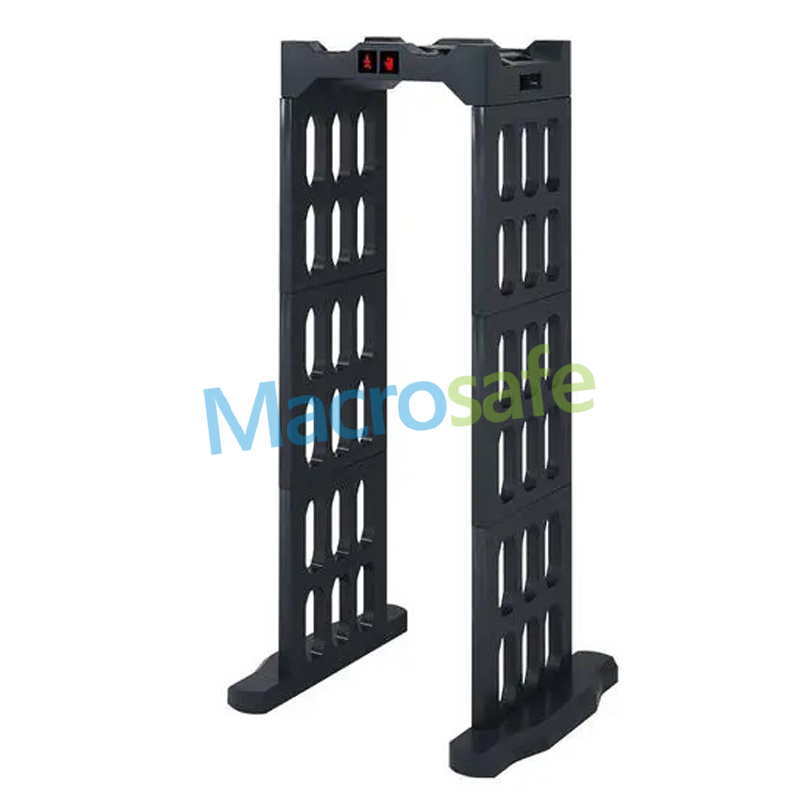
Portable Walk Through Metal Detector
5. Multi-Sensor Metal Detectors: These detectors utilize multiple detection techniques like metal detection, X-ray imaging, and fingerprint scanning to enhance security and identify potential threats more accurately.
1.2 Installation of walk through metal detectors
1. Open the package and take out the door panel, control box, power cable and user manual and other accessories.

2. Use 8 screws to fix the control box and the left and right gate panels (as shown in the figure), open the cover of the control box, and connect the data cable.

3. After connecting the data cable, close the cover, erect the security door, connect the power supply, and turn on the machine. Done!
2. Can walk through metal detector work with turnstile gate?
Yes, Macrosafe provides integrated solution which links the walk through metal detector with turnstile gates for enhanced security. Individuals must pass through the metal detector before gaining access through the turnstile gate.
3. How much does a walk through metal detector cost?
Walk through metal detector prices can range from a few hundred to several thousand dollars. Factors such as the features, sensitivity, and customization options can all influence the final cost. For an accurate quote, please contact us right now!
4. Do walk-through metal detectors detect aluminum?
Yes, security gates are capable of detecting a variety of metal products, including aluminum blocks, aluminum sheets and aluminum products.
5. What do walk through metal detectors detect?
Walk-through metal detectors are primarily designed to detect various metal items carried by individuals. Specifically, they can detect:metal items, electronic products and precious metals.
1. Electronic products such as chips, memory devices, circuit boards, hard drives, mobile phones, MP3 players, translators, recording devices, and other electronic devices.
2. Metal items including steel pipes, cutting tools, firearms, lighters, and various other metallic objects
3. Precious metals, such as gold and silver jewelry.
3. Other metal objects such as wires, cables, electrical appliances, electroplated items, die-cast parts, plumbing supplies, and precious metals like copper and aluminum,
4.Other everyday items like watches, hardware products, keys, eye glass and embroidery needles.
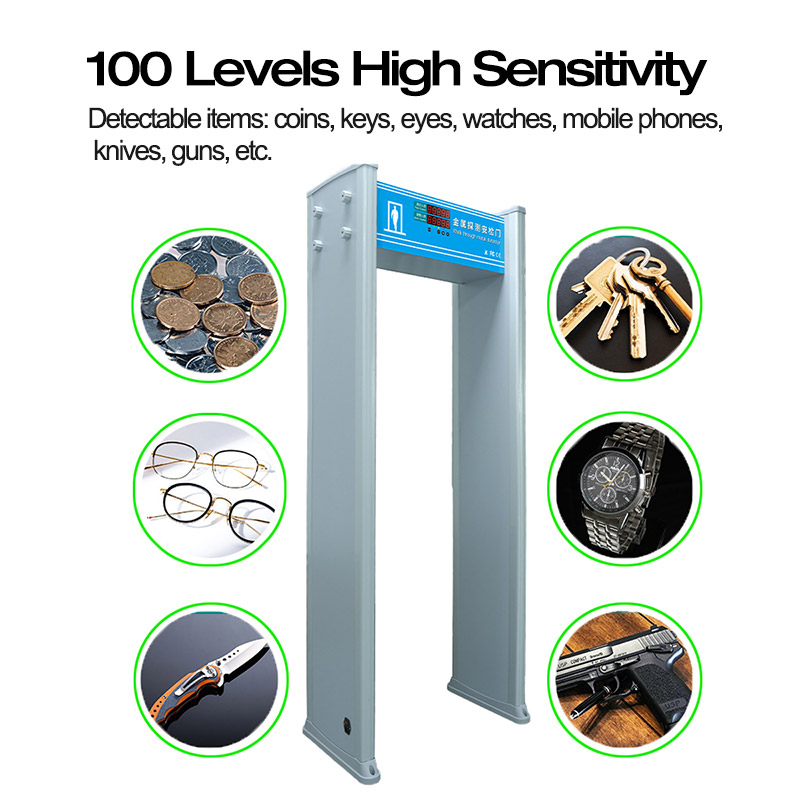
6. Are walk through metal detectors safe?
Yes, walk-through metal detectors are safe when used in accordance with standard operating procedures.
Before explaining why they are safe, we can first understand how walk through metal detectors work. Their working principle is based on electromagnetic induction: when current passes through the coil, a magnetic field is generated. If a metal object passes through this magnetic field, a magnetic field will also be generated inside the metal object, causing a change in the original magnetic field. The security door has a built-in high-sensitivity detector that can detect such small changes and prompt the operator through an audible and visual alarm system.
So is this electromagnetic field harmful to the human body? the answer is negative. First of all, because the intensity of the magnetic field it generates is extremely small, far lower than the electromagnetic radiation level of household appliances such as mobile phones and televisions. Organizations such as the International Council for Electromagnetic Radiation Protection (ICNIRP) and the World Health Organization (WHO) have pointed out that the impact of low-intensity magnetic fields on the human body is negligible.
Secondly, the magnetic field generated by the security gate is instantaneous. The time that people pass through the walk through metal detector is very short, usually no more than a few seconds, so the magnetic field they are exposed to is extremely short. Even under abnormal circumstances, such as the walk through metal detectors malfunctioning and working continuously, the electromagnetic field it generates is not enough to cause long-term adverse effects on the human body.
7. Can a pregnant woman walk through metal detectors?
Yes. Walk throught metal detector has low power and produces very little electrical radiation, which is smaller than the radiation from commonly used mobile phones and computers, so it has no adverse effects on pregnant women and fetuses.
If there are specific concerns about walking through a metal detector, alternative security screening options may be available and should be discussed with security personnel.
8. Can you walk through a metal detector with a pacemaker?
Yes, it is generally safe to walk through a metal detector with a pacemaker. Pacemakers are designed to be shielded from the effects of metal detectors and should not be affected by them. However, it's always a good idea to inform the security staff about your pacemaker before going through the metal detector.
9. How does a walk through metal detector work?
Walk-through metal detectors are a common security screening device used to non-invasively detect and screen individuals and items for metallic objects. The functioning of these detectors is based on different detection technologies, which enable them to achieve this crucial security task. The commonly used detection technologies include metal detection, X-ray technology, and microwave technology.
Metal Detection Technology
One of the primary technologies utilized in walk-through metal detectors is metal detection. This involves the use of electromagnetic or magnetic sensors to identify the presence of metallic objects on a person's body or within their belongings. When an individual passes through the metal detector, the electromagnetic/magnetic field is perturbed by the presence of metal, causing the detector to emit an alarm signal alerting security personnel to a potential threat.
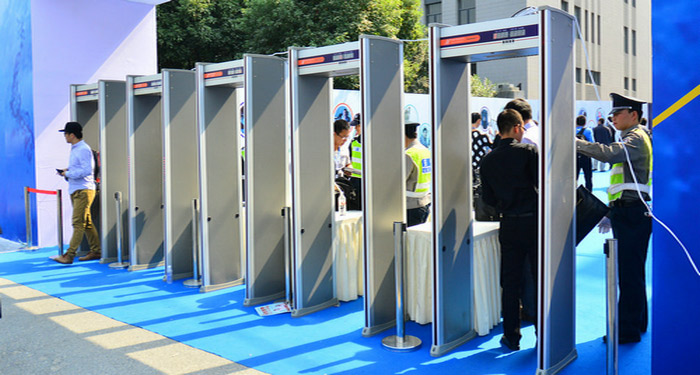
X-Ray Technology
In some advanced walk-through metal detectors, X-ray technology is employed to provide enhanced screening capabilities. X-ray scanning allows security personnel to visualize the interior of items being carried by individuals, enabling them to identify any concealed metallic threats. This technology provides a more detailed and comprehensive analysis of the scanned items, enhancing the overall security effectiveness of the metal detector.
Additionally, walk-through metal detectors make use of microwave technology to detect metallic objects. Microwave-based detectors emit low-power microwave radiation, which is reflected back when it encounters metallic objects. The detector's sensors analyze the reflected signals to identify the presence and location of metallic items on an individual.
9.The walk-through metal detector, also known as a metal detector gate, has a history dating back to the mid-20th century. The first-ever walk-through metal detector was invented in the 1960s, marking a significant milestone in security technology.
10. When were walk through metal detector invented?
1960s - Invention and Industrial Applications
* The first walk-through metal detectors were invented in the 1960s for industrial applications such as mining and construction.
1970s - Security Screening and Aviation Industry Adoption
* In the 1970s, walk-through metal detectors were introduced for security screening purposes, primarily in the aviation and transportation sectors.
1980s - Prison Security and Expansion
* In the 1980s, the escalating incidents of violence and security breaches in correctional facilities led to the widespread adoption of walk-through metal detectors in prison facilities across developed countries.
1990s - Workplace Security and Electronics Manufacturing Industry
* In the 1990s, as the electronics manufacturing industry grew, large electronic companies began using walk-through metal detectors and handheld metal detectors in the workplace to monitor employee behavior and reduce product theft.
2000s - Advancements in Technology and Global Adoption
* In the 2000s, walk-through metal detectors continued to play a vital role in ensuring public safety and security across various sectors globally. Advancements in technology and design led to more efficient and effective security screening systems.
Today - Continued Importance and Future Developments
* Today, walk-through metal detectors remain a crucial security measure in various settings, including airports, prisons, government buildings, and commercial spaces. They are an essential tool for detecting hidden weapons, contraband, and other security threats. With ongoing technological advancements, walk-through metal detectors are likely to become even more sophisticated and effective in the future.
11. What metals set off walk-through metal detectors?
Metals like steel, iron, copper, aluminum, brass, gead, gold, silver, stainless Steel, titanium, nickel, etc, can set off walk through metal detectors.
12. Can you walk-through a metal detector with a phone?
When you walk through a metal detector with a phone, it would trigger the metal detector because the phone contains metal components such as the battery, speakers, and internal circuitry. Some metal detectors are designed to filter out signals from items like phones to reduce false alarms.
And there is also one detector specifically designed to detect mobile phones and exclude other metals.
13. What is walk through scanner?
A walk-through scanner, also known as a walk through metal detector, is a type of anti-terrorism detection equipment that is designed to detect the presence of metal objects on a person as they walk through the device. These scanners are commonly used in security checkpoints at various facilities, including airports, government buildings, and public events.
14. FAQ about walk through metal detector
Walk through metal detector price
Prices can range from 300 dollars for basic models to 2000 dollars for advanced systems like movable walk through metal detector.
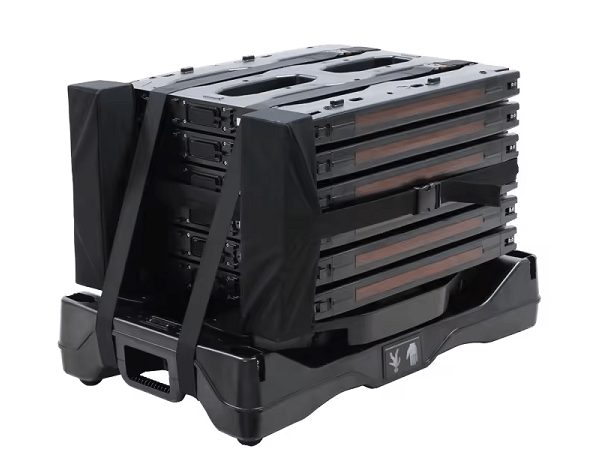
Do walk-through metal detectors detect guns?
Yes, walk-through metal detectors are designed to detect metal objects, including guns.
Can a newborn go through a metal detector?
Yes, it is safe for everyone including newborns and kids to pass through a metal detector.
Can you go through a metal detector with a knee replacement?
Yes, you can go through a metal detector with a knee replacement. Most knee replacements are made of metal and plastic components, and these materials are typically not affected by standard metal detectors.
Can you walk through a metal detector with a pacemaker?
Yes, individuals with pacemakers can usually walk through metal detectors without any issues. Most modern pacemakers are shielded and designed to be resistant to interference from everyday devices, including metal detectors.
15. Walk through metal detector dimensions
Walk-through metal detectors typically measure around 88 inches in height, with widths ranging from 28 to 33 inches and depths between 19 to 23 inches. This dimension ensures that there is enough space for a person to pass through without causing congestion.
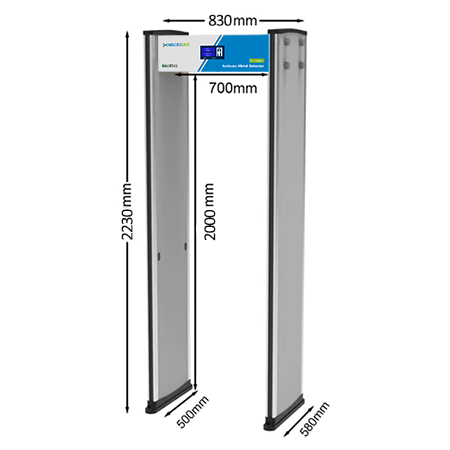
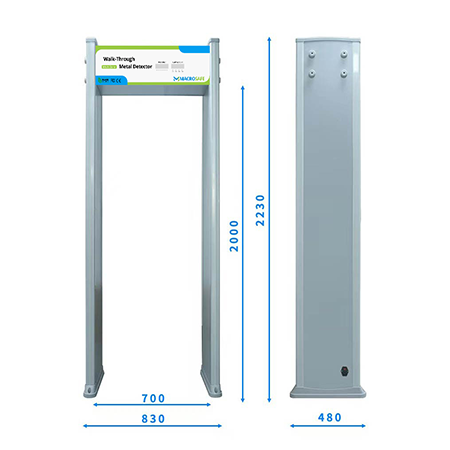
16. What is the difference between single zone and multi zone DFMD?
Multi-zone DFMD offers precise threat localization, allowing independent sensitivity adjustments for each area (e.g., zones 6/11/18/24/33). In contrast, single zone DFMD can only detect the presence of a threat without precise localization and lacks independent sensitivity adjustments.
1. Sensitivity level
- Single Zone DFMD: Usually operates with a single sensitivity level across the detection zone.
- Multi Zone DFMD: Allows for varying sensitivity levels in different zones, enhancing detection capabilities based on the metal object's location.
2. Localization of Threat Objects:
- Single Zone DFMD: Provides limited information about the location of the metal object on the person being screened.
- Multi Zone DFMD: Offers detailed information about the location of the metal object by identifying the specific triggered zone.
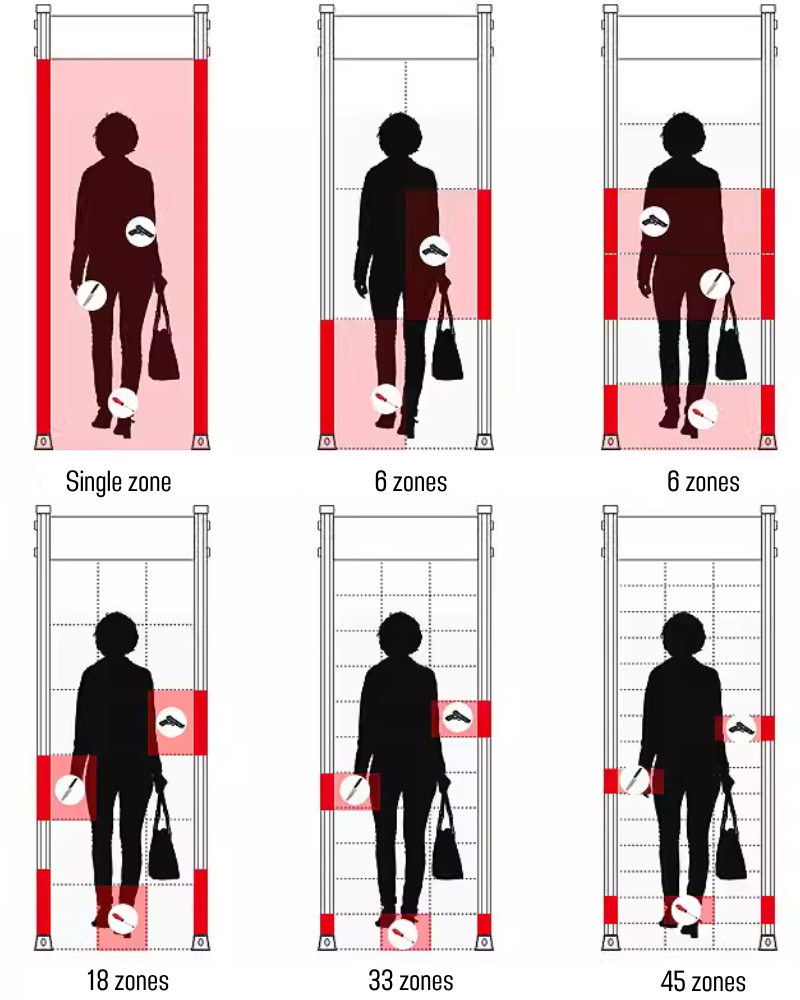
3.Accuracy and Precision:
- Single Zone DFMD: May have limitations in accurately pinpointing the location of the metal object on the person passing through.
- Multi Zone DFMD: Provides more precise and accurate localization of the threat object due to multiple detection zones.
4. Flexibility and Customization:
- Single Zone DFMD: Generally simpler in design and operation with fewer customization options.
- Multi Zone DFMD: Offers more flexibility and customization options to suit specific security requirements and environments.
5. Cost and Investment:
- Single Zone DFMD: More budget-friendly in terms of initial investment and maintenance costs.
- Multi Zone DFMD: Requires a higher initial investment due to advanced features but offers enhanced security capabilities.
6. Security Applications:
- Single Zone DFMD: Suitable for basic security screening in low-risk environments.
- Multi Zone DFMD: Ideal for high-security applications in environments requiring precise threat localization.
17.What metals cannot be detected by a walk through metal detector?
Non-magnetic metals such as aluminum, pure copper, and stainless steel cannot be detected by a walk-through metal detector due to their low magnetic permeability, which makes them undetectable by the magnetic field induction technology used in the metal detectors.
It's important to note that the effectiveness of metal detection can also depend on the sensitivity and quality of the specific walk-through metal detector being used, environmental factors, and the configuration of the metal object in question.
18. What is the main drawback to using walk through metal detectors?
High sensitivity is essential for security purposes, it can also lead to frequent false alarms when people are wearing items such as jewelry, metal accessories, or even underwire bras. These false alarms can be frustrating for both the individuals being screened and the security personnel. In addition, walk through metal detectors cannot detect some non-metallic items, such as plastics, liquids, etc.
Good news is that for multi-zone walk through metal detectors, the sensitivity of each zone can be adjusted independently. This function allows the sensitivity to be adjusted according to the use environment, thereby effectively reducing the false alarm rate. Please
contact us for further setup.









